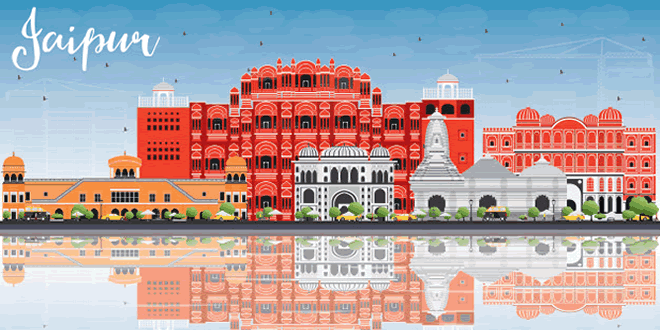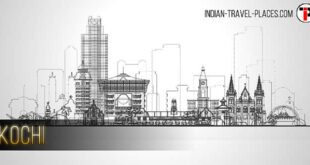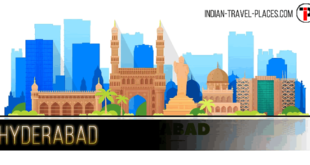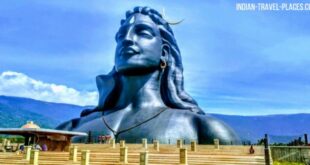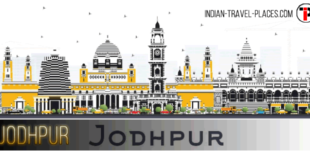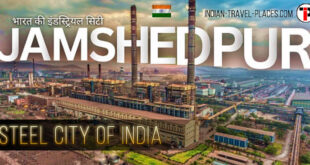Jaipur is the largest city in Rajasthan and was built in the eighteenth century by Sawai Jai Singh as India’s first planned city. Jaipur is a major tourist attraction amongst Indian as well as international travellers. It belongs to the tourist Golden Triangle of Delhi, Jaipur and Agra.
| Name: | Jaipur – The Pink City of India |
| Location: | Jaipur District, Rajasthan |
| Climate: | Summers: 45° C (Max), 26° C (Min) | Winters: 22° C (Max), 5° C (Min) |
| Best Time to Visit: | October to March |
| Nearest Airport: | Jaipur International Airport |
| Railway Station: | Jaipur Railway station |
| Must Visits: | Amber Fort, Jaigarh Fort and Nahargarh Fort, City Palace, Rambagh Palace, Jal Mahal and Jantar Mantar |
| Language Spoken: | Hindi, Rajasthani and English |
| STD Code: | 0141 |
Jaipur is the capital city of the Indian state of Rajasthan, situated in the eastern semi-desert land. It houses some of the most ancient monuments and palaces that are made of traditional pink stones. Most of the city houses are also painted in pink color, which explains as to why the city is popularly referred to as the “Pink City of India“. Jaipur was founded by Maharaja Sawai Jai Singh II, the ruler of Amber on November 18, 1727. This beautiful city is spread over an area of about 200 square kilometers. The Banas River and Banganaga River are the two major water sources flowing through the district of Jaipur.
Being the capital city, the city heads the administrative sector of the whole Jaipur district. Jaipur is situated at an altitude of 431 m above the sea level and thus, has a hot semi-arid climate with extremely hot summers and mild winters, with an annual rainfall of about 650 mm during the monsoon months (July-September). It is located centrally on National Highway No.8 (linking Delhi to Mumbai) and has a strong transport system. Due to its location, cultural heritage and historical importance, the city is marked as a major destination in the famous golden triangle tours of North India.
Jaipur had experienced a glorious history of its existence. It was the first well planned city of its time and was designed by a famous Bengali architect, Vidyadhar Bhattacharya. This old city features a grid system with wide straight avenues, roads, streets and lanes arranged in nine rectangular sectors (chokris). During the British rule, Jaipur was the capital of the princely state of Jaipur. Thus, the structure and architecture of the city truly reflects the imperial royalty and magnificence. Apart from the historical importance, Jaipur stands as one of the major educational cities in North India. Besides having a strong history and rich culture, Jaipur is rapidly growing as a major business centre with all the features of a metropolitan city.
According to a recent international survey, Jaipur was ranked as the 7th best place to visit in Asia. It is also known to be the largest exporter of gold, diamond and stone jewelry in Asia and the only city finishing blue diamond or Tanzanite in the world. Along with this, it is a hub of traditional artifacts and textiles that makes it a potential shopping destination for all kinds of travelers. The city has numerous tourist attractions in the form of historical forts like Amber Fort, Jaigarh Fort and Nahargarh Fort, City Palace, Rambagh Palace, Jal Mahal and Jantar Mantar. Apart from the forts, the various festivals celebrated herein depict the colorful and vibrant spirit of this princely city. So what are you waiting for? Come and explore this Pink City the next time you plan a holiday!
Best Time To Visit Jaipur
Jaipur, which is hailed as Pink City, is one of the most happening tourist destinations in India. Located amid desert, this princely state was found by Maharaja Sawai in 1727. Designed and planned by Vidyadhar Bhattacharya, the city of Jaipur stands as an exemplary model of Vastu Shastra and Shilpa Shastra. Sawai Ram Singh painted the city pink to welcome the Prince of Wales and hence the name “Pink City“. The city’s main buildings and palaces took four long years to be constructed. Jaipur is the best representative of the Indian culture with its impressing number of traditions, festivals, norms, clothes and architecture. Today, it is a fastest growing city, which contributes towards much of India’s information technological developments. Winter is the apt climate for an outsider to visit Jaipur and enjoy its beauty. As the city is located in deserts, visiting the city in summer is not recommended.
When To Visit Jaipur
Jaipur Seasons
Jaipur essentially has three main seasons – summer, monsoon and winter. Jaipur enjoys a long summer that stretches across the months of March, April, May and June. It’s a bad idea to visit Jaipur during these months as searing sun and arid climate promises to scorch you down if nothing else. Monsoon, which persists from July to September is marked with high humidity and scanty rainfall and isn’t really the ideal time for a visit. Winter, which persists from October to mid-March, is by far the most pleasant time of the year and ideally the best time to explore the city.
These winter months promises to be the ultimate time for the tourists to explore the rich legacy of the place. During winter, the sun is less intense, the weather is more pleasant and the temperature is more tolerable. The city looks more spectacular during this time with the evenings offering most awesome recreations and the food platter brimming with luscious delicacies. To cut short the long story, the best time to visit the incredible Jaipur is during the winters.
Jaipur Gardens
Jaipur, better known for its arid climatic conditions and diverse topography, is flanked with acres of dry desert land on one side and hilly tracts on the other. But what most of us don’t know is that the “Pink City”, which is the home to many hill forts and historical landmarks, has exquisitely beautiful landscapes to its name. The picturesque Jaipur, with miles of desert sand on one side and well-planned gardens on the other, serves as the natural habitat to a wide range of flora and fauna and has a wealth of green that adds to the city’s elegance. Most of the gardens and national parks in Jaipur are maintained and preserved by the Rajasthan government as a “green” initiative to maintain the eco-system of the city. You cannot come to Jaipur and go away without visiting the gardens here. The multitude of breath taking sceneries, sheer size and design of these lush green properties makes the gardens in Jaipur a worthy stopover. There are quite a few popular gardens such as the Sisodia Rani Ka Bagh, Ram Niwas Gardens and Vidyadhar Garden. Read further to explore more on the gardens in Jaipur.
Famous Gardens Of Jaipur
Ram Niwas Bagh
Built in 1868 by Maharaja Sawai Ram Singh, this garden was initially spread across a whopping 76 acres of sprawling lawns, flowerbeds and captivating fountains. Today, however, the garden stands confined to 33 acres of scenic lands while the remaining land has been divided into a zoo, aviary, herbarium, museum and sports complex. One of the major attractions of Ram Niwas Bagh is the famous Albert Hall museum that houses an exquisite collection of paintings, sculptures, objects d’art, an Egyptian mummy, natural history specimens, and a beautiful Persian carpet. Apart from this, the garden also has a modern art gallery, an auditorium and an open-air theatre. This garden is open to the visitors on all days between 9.30 am to 4.30 pm, except on Fridays.
Vidyadhar Garden
The Vidyadhar Garden is one of the best gardens in the city. Built in memory of late Vidyadhar Bhattacharya, the designer-architect of Jaipur, this garden is an interesting specimen of Shilpa Shastra. Located 8 km outside the city walls on Jaipur-Agra Highway, Vidyadhar Garden is nestled between two rocky hills, which gives this place its much coveted scenic status. This sprawling garden, with its beautifully laid flowerbeds, chiseled fountains, sylvan lakes, pictorial vineyard, stunning galleries and Mural paintings, is a true feast for the eyes. The best time to visit this garden is during early evening when the garden is illuminated with bright lights.
Sisodia Rani Ka Bagh
Maharaja Sawai Jai Singh II built this natural sanctum in 1779. The garden, named after Queen of Sisodia of Udaipur, was a token of love from the king to his queen, who was worn down with domestic difficulties and daily court life. This garden, laid in Mughal style, has a wide spread of flowerbeds, fountains, wide pavilions and frescos depicting Lord Krishna in different scenes. This multi-level garden has an old world charm about it that never fails to woo its visitors. Located 6 km away from the Jaipur-Agra Highway, this garden truly displays mankind’s forethoughtfulness and skill. The best time to visit this garden is between October and March. This garden is open to the visitors on all days from 8 am to 6 pm.
Kanak Vrindavan Valley
The Kanak Vrindavan is a charismatic place set in the foothills of Nahargarh Hills. This scenic garden is walled by three important fortress of Jaipur – the Nahargarh Fort, the Amber Fort and the Jaigarh Fort. Believed to be styled after Vrindavan, the birthplace of Lord Krishna, this valley has long expanding lawns with beautiful watercourses, small brooks and ponds. Kanak Vrindavan is said to attract many migratory birds like spotted doves, kingfishers and the Indian roller. A trip to Jaipur would be incomplete without a visit to the famous Kanak Vrindavan Valley.
History of Jaipur
Jaipur, also called as the “Pink City”, is almost synonymous to elegance and art. It’s said that Maharaja Sawai Jai Singh II, the ruler of Amber, founded the city and remodeled it as his capital. Located amidst exotic locale, this princely state has been the home to the royal brave hearts and fearless warriors. Today, Jaipur ranks among one of the fastest growing cities of India and has its fair share of urban hipsters as well as traditional crusaders. This city, which is portrayed more by western films than native, is also one of the few cities that have the oldest Sanskrit college. In world’s jewelry scenario, the city is known as the largest exporter of diamond, gold and other precious stones. One should experience the life in Jaipur, at least before saying adieu to life, no matter, from which zone of this planet he/she belongs. Amber Fort, Hawa Mahal, Jaigarh Fort, Nahargarh Fort, City Palace, Jantar Mantar, Rambagh Palace and Jal Mahal are some of the major attractions of this place. To experience the real flavor of the princely town, trail down the history of Jaipur and explore its grand magnificence.
Overview Of Jaipur History
Jaipur, The Royal Capital
In 1727, Maharaja Sawai Jai Singh II, had come to a conclusion that it would be better to shift his capital from Amber to a city that could be a perfect place for his expanding population. Water scarcity was another reason that forced Maharaja Sawai Jai Singh to consider this decision. Being a ruler with an intense clarity of things, Maharaja Sawai studied the art and science of architecture before moving his capital to Jaipur from Amber. Jaipur is said to have come into existence as a classical example of a well made city, which is accurately based on Vastu Shashtra. It was made with the help and wisdom of Vidyadhar Bhattacharya, who was a clerk in King’s administration. Being a very intelligent individual, Vidyadhar Bhattacharya took the right measures to protect the city and the royal palaces from the alien forces. He designed the city and its proud structures in a way that it could resist the violent agitation from foreign forces. Security became the most important concern of Maharaja Sawai as security threat from Marathas made him alert.
It’s Construction
The construction of the ‘Pink City’ had begun in 1727 and it almost took 4 years to complete the major infrastructure and buildings. Records reveal that the buildings of this place have been styled according to Shilpa Shastra, the science of Indian architecture. Primarily, the city was divided into nine blocks, of which two served as the state buildings and royal palaces and the other seven were given to the public. Seven strong gates were built along with huge walls to protect the people from foreign invasion. The city got its name when Sawai Ram Singh decided to paint the city in pink to welcome the Prince of Wales, in 1853.
Jaipur, Today
Even today, the avenues remain painted in pink and that adds an exotic touch to the location. By 1900, the population of the state had increased to whopping 160,000. Today, Jaipur is a growing metro, which plays an important role in information technological developments for the country.
How To Reach Jaipur
Jaipur, with its archeological splendor and pink colored manifestation, will grab your eyes as soon as you step in. Touted as the first planned city of India, the dream like locales have been constructed to great perfection and serves as a visual treat for the eyes. Studded with tourist attractions like Jantar Mantar, the magnanimous Jal Mahal, beautiful Amber Fort and more, a trip through the city’s citadels and monuments will leave you in awe. As the city is well connected to all the other major cities of India, it is flocked with tourists all the year round. The city is well connected by road, rail, and air and boasts of excellent road and air services. A trip to this royal heritage is likely to thrill you with its magnificence, splendor and charm. Just pack your bags and head out for this glorious city and explore its grandeur. To know more on how to reach Jaipur, read on.
Traveling To Jaipur
By Air
The airport is situated close to Sanganer, almost 13 km to the south of Jaipur City. Domestic airlines connect the city to other major metros of India and flies regular flights to Delhi, Kolkata, Agra, Ahmedabad, Mumbai, Jodhpur and Udaipur. The Jaipur airport, also flies international flights to London, Dubai, Sharjah and Muscat.
By Rail
Jaipur Railway Station is one of the major stations in the whole of Rajasthan. This station connects Jaipur to most of the cities in India. Train fares are considerably cheaper here which makes railways one of the most preferred forms of travel options for the tourists. There are three major stations in Jaipur Junction – One is main city station, other one is the Durgapura Station and third is the Gandhinagar Station. However, if you are game for a luxury ride, then don’t forget to take a trip across the deserts of Rajasthan on “Palace On Wheels”.
By Road
Jaipur is well-connected to the major cities of India by road and tourists don’t really have to kill hours to get a bus here. Jaipur has a remarkable bus service that can make your trip a pleasant experience. You can avail the deluxe buses and AC coaches or even opt for regular government buses as per your convenience. Rajasthan State Road Transport Corporation plies regular buses to the capital city of India that can take you to Delhi in just six and half hours. You can board a passenger bus from Narayan Singh Circle or the main Sindhi Camp bus stand. It’s better to book tickets in advance for a comfortable journey. If you plan to take a bus from the Delhi airport to Jaipur, you can get down at Dhaula Kuan and take a taxi from the same spot. This route will be a lot easier and less time-consuming than travelling down the other congested streets in the city.
Jaipur Food
Dotted with hilltop forts, royal palaces and innovative structures, the city of Jaipur has earned affection as the spice court of the country. Apart from lush landscapes, the city of Jaipur has an array of colorful, spicy and unique traditional feasts, which proudly represents the rich royal culture of the land. Just like its glorious architecture and serene beauty, the gastronomy of Jaipur is highly influenced by its availability of ingredients and historical past. The food culture of this magnificent desert land is as rich as its glorious past. With lot of curds, ghee and dry fruits, the ultra spicy, rich food of Jaipur is a true treat for the food fanatics. Apart from authentic Rajasthani food, the restaurants in Jaipur offer different type of regional and international cuisines. Thus on your trip to Jaipur, leave all worries aside and enjoy the vibrant food along with its lush topography. If you want to know more about the food culture of Jaipur, then go ahead and explore the article.
Jaipur Food Guide
Rajasthani Cuisines
Jaipur, the land of vibrant colors and rich culture, is popular for its traditional Rajasthani cuisines. On your visit to Jaipur, don’t forget to try some of the mouthwatering foods of the royal city. Vegetarian being the main part of food, Rajasthanis relish them with hot spices, ghee and dry fruits. Since Rajasthani cuisine has been passed on from one generation to the other, one can still experience an age-old charm and flavor about it. Some of the widely loved Rajasthani cuisines are dal-bati, churma, rabdi, ghewar, tarfini, chaavadi, khaddi, vadi, googri, makki ki raab and the list is endless. To treat your taste buds to authentic Rajasthani food, hop into the Surya Villas restaurant inside the Le Meridian Hotel. Some of the other popular Rajasthani restaurants are Aangan at Amer Road, Laxmi Misthan Bhandar at Johari Bazar and Apno Gaon Restaurant at Sikar Road.
Street Food
The street food culture of Jaipur is as old as the city itself and attracts people with its explicit taste and reasonable cost. With roadside vendors dishing out snacks, chaats, sweets and other munchies, street food in Jaipur is a feast in itself. On your visit to Jaipur, do enjoy the characteristic Rajasthani street food namely roasted corn (bhuttas), pakores, spicy chana gram, mirchi bada, kachori, ghewar etc. Apart from conventional Rajasthani food, the street food also offers some of the exceptional popular chats such as pani puri, bhel puri, masala puri, samosa etc. From spicy hot dishes to yummy sweets, street of Jaipur has everything to offer you. Although there are wide number of street stalls at every corner of the city, the best is available at the old city area and near popular bazaars of Jaipur.
Indian Cuisine
Just like any other city of the country, Jaipur is also popular for its exotic array of regional cuisine. Whether it is North Indian, South Indian, Punjabi, Gujarati or Bengali, Jaipur has good number of restaurants that offers a wide range of regional delicacies. So on your trip to Jaipur, there is no need to skip from your favorite regional cuisines. Some of the restaurants in Jaipur where you can enjoy the traditional Indian cuisines are Goth at Amer Road, Khana Khazana at Subhash Nagar, Deep Restaurant at Sindhi camp and Sankalp at C Scheme.
International Cuisine
Jaipur being the major tourist attraction in India, there are number of international cuisine restaurants to allure the tourists from worldwide. From Chinese to Thai to Italian and Mexican, Jaipur offers a wide variety of delicious cuisines from around the world. Some of the popular restaurants for international cuisines are Muskan at Vidhyadhar Nagar, The Niros at Pink City, Copper Chimney at MI Road and The Temptations at Jhotwara.
Museums In Jaipur
Jaipur, the home to majestic forts, intricately designed temples and decorated havelis, is a treasure trove of the departed epoch. Although Jaipur does not have a number of museums to boast of, the wide antique collections, miniature paintings and souvenirs of royal legacy are good enough to mesmerize you. On your visit to the museums here, you can see various artifacts, precious stones, frescos, musical instruments, and other rare relics that epitomize the city’s rich heritage and opulence of the past. On visiting the pink city, don’t forget to visit two of Jaipur’s oldest museums- ‘The Albert Museum’ and ‘The City Palace Museum’. These two museums, which stand as symbol of the art and culture of the bygone era and showcases the regal legacy of the city, attracts thousands of visitors every year. The museums in Jaipur are worth visiting. Explore this article further and you will truly know why.
Jaipur Museums
The Albert Hall Museum
This museum is one of the oldest state museums in the city. Located outside the city, in the heart of Ram Niwas Garden, this rambling edifice is surrounded by expansive greenery and beautiful fountains. The museum itself has an interesting history of its own to relate. Named after King Edward II, this historical repository was built in 1876 by Sir Samuel Swinton Jacob. The museum, also known as Central Museum, has an extensive collection of prized artifacts like unique paintings, precious stones, metal objects, ivory collection, traditional carpet work, wooden carvings and sculptures, colorful tribal pieces and crystal work etc. Albert Hall is open to the visitors on all days from 10.30 am to 4.30 pm.
City Palace Museum
The sprawling City Palace Museum is an ostentatious piece of architecture wadded with several structures, a lavish gardens, exhibition areas, and ornate temples. Some of the major attractions of this museum are Chandra Mahal, Mubarak Mahal, Mukut Mahal, Maharani’s Palace, and Pitam Niwas Chowk. Diwan-I-Am and Diwan-I-Khas are other two major attractions of this rambling museum. These two vibrantly decorated chambers showcase the real Rajasthani art style and represent the regal grandeur with �lan. On your trip to this museum, you will get to see various art forms belonging to Rajput, Persian and Mughal era. There is a vast series of objects on display like musical instruments, glasswork, ethnic clothing, traditional games, armory, and other objects to signify the legacy of the past. The museum is situated at the very heart of the city and is open to the public from Monday to Saturday between 10 am to 5 pm.
Doll Museum
The doll museum is another unique museum in Jaipur, which is highly popular among tourists and students. The doll museum was constructed in 1974 and is located 4 km away from the heart of the city. A visit to the famous Doll Museum in Jaipur is likely to be a memorable experience for the visitors. This museum, which houses dolls of different culture, tradition, and ethnicities from all across the world, offers a real treat to the visitors. Dressed in classical, ethnic, national and bridal wears, the dolls here typifies the culture and tradition of diverse lands. A trip to these museums sums up as a true educational experience for the students and children. The museum is open on all days from 12 pm to 7 pm.
Maharaja Sawai Man Singh II Museum
Maharaja Sawai Man Singh II Museum, located inside the City Palace, was constructed in the year 1959. This museum, which exhibits old paintings, war weapons, armory, manuscripts, books and clothing, has three separate galleries dedicated to the antique wares collected by Maharaja of Sawai Man Singh the second. The three galleries are – Mubarak Mahal, which showcases a wide spread collection of traditional clothes worn by the Maharaja himself, Silehkhana or the armory gallery, which displays handguns, pistols, swords, lances, knives, arrows in various shapes and sizes, maces, shields made out of crocodile and buffalo skin, and Art Gallery, which holds a mesmerizing collection of frescos, books, manuscripts, photos, instruments, and a rare collections of Indian epics in the Persian language.
Museum of Indology
Museum of Indology has an exceptional collection of folk and Tantric art items, paintings done on rice, manuscripts, fossils, timepieces and currency notes. The museum was constructed in 1960 by Ram Charan Sharma. This place holds a vast collection of illustrated and un-illustrated manuscripts, historical documents, a large collection of paintings, interesting textile designs and a huge collection of sculptures. The museum is open to the visitors on all days from 10 am to 5 pm on all day, except Fridays.
Art Galleries
Apart from sprawling museums, Jaipur also has quite a few art galleries like Juneja Art Gallery, Modern Art Gallery, and Anokhi Museum of Hand Printing to offer to its visitors. Theses art galleries are a visual treat to any art enthusiast. They are open on all days of the week from 10.00 am to 4.30 pm.
Places To Visit In Jaipur
Being the historical treasure trove of Rajasthan, the effervescent city of Jaipur fascinates the visitors with its exotic scents of spices, vibrant sarees and colorful architecture. Flooded with extravagant palaces, majestic forts and sanctified temples, Jaipur is the color of India, which proudly showcases its royal footprints. As a gateway to the desert state, Jaipur treats its visitors with glorious pink tint. Dotted with magnificent architecture, carpeted lush green gardens and serene beauty, Jaipur is truly one of the major tourist attractions in India. On your trip to the royal city, you will find yourself completely beguiled by the imperial beauty of its majestic architecture. With bravura sites and monuments to its name, a visit to the pink city would imprint an indelible impression in your minds. To know more about the major tourist attractions of Jaipur, go ahead and explore this article. The heavenly voyage of Jaipur is sure to impress you to no limits.
Tourist Attractions In Jaipur
Hawa Mahal
Hawa Mahal, earlier known as ‘Janana Deori’, was built by Sawai Pratap Singh in 1799. This magnificent and fanciful architecture consists of five storey pyramidical facade with nearly 953 overhanging windows with pierced screens, domes and steeples. Situated in the centre of Jaipur, the building was originally constructed for the royal women of the fort so that they can enjoy their time by watching the lively bazaar and processions on the busy streets. Today, this spectacular red and pink royal concord stands as one of the most glorious reminiscence of the past. You can visit Hawa Mahal on any day between 9 am to 4 pm.
City Palace
City Palace, one of the major tourist attractions of the Pink City, was built by Maharaja Jai Singh II of the Kachhwaha race of Rajput’s. This architectural beauty, that blends Rajasthani with Mughal styles, comprises of many small palaces and halls namely Mubarak Mahal, Badal Mahal and Chandra Mahal. Apart from this, the City Palace also houses famous Sri Govind Temple and City Palace Museum, which boasts of a wide collection of royal costumes, beautiful shawls and Banarasi saris. With number of pillars, arches and traditional Rajasthani artifacts, City Palace is a must visit place in Jaipur. Do visit this glorious architecture from 9.30 am to 5.30 pm to explore its sheer beauty.
Jantar Mantar
Jantar Mantar, located adjacent to City Palace, is one of the five remarkable observatories of King Jai Singh, built between 1727 and 1733. The king’s interest in astronomy is very well reflected in Jantar Mantar. Constructed with stone and marble, the building looks like any other gallery but is the home to some of the complex instruments of astronomy. Some of the instruments in Jantar Mantar are small Kranti, Dhruva, Narivalya, Dhruva, Digantra, Rashivalayas and Unnathamsa. If you are interested in astronomy then you can visit Jantar Mantar on weekdays between 9 am to 4.30 pm.
Birla Mandir
Birla Mandir, situated just below the famous Moti Dungri Fort, is a stunning white marble temple dedicated to Lord Narayan and his wife Laxmi. This marvelous white beauty was built in 1988 by Birla Group of Industries, one of the leading business barons of India. The temple, which attracts large number of tourists every year, looks astonishingly beautifully when it glows at night.
Central Museum
Central Museum one of the oldest Museums in Rajasthan is located in the famous Rama Niwas Garden. The marble structure of museum was designed by Sir Swinton Jacob and was inaugurated by Prince Albert in 1863. The museum, which now serves as a State Museum of Rajasthan, has a huge collection of art, history, paintings, dolls, carpets, traditional costumes, armory etc. Apart from this, the museum has a separate section for music and dance lovers. You can enjoy the erudite journey of museum on all days from 9.30 am to 4.30 pm.
Swargasuli
Swargasuli also known as Isra Lat was built by Sawai Ishwari Singh in 1749.Located at the junction of the Tripolia and Gangori markets near the Tripolia Gate, this Rajasthani architecture is a dazzling seven-storeyed minaret with intricate latticework. The sky-piercing minaret was built in commemoration of Ishwar Singh’s victory over armies of Mewar and Marathas. Today this spectacular minaret, which offers breathtaking view of the city, is one of Jaipur’s most visited tourist spot.
B. M. Birla Planetarium
B. M. Birla Planetarium at BM Birla Science & Technology Center near statue circle owes its existence to famous industrialist Mr. B.M. Birla. The planetarium, spread across 9.8 acres of land, houses a science museum, information processing and dissemination cell, auditorium, research centers and a planetarium. Everyday planetarium offers a special audio-visual show on the scientific researches and celestial bodies, which attracts number of students. Museum remains open for your service on all days except on last Wednesday of every month.
Ram Niwas Bagh
Ram Niwas Bagh built by Maharaja Swai Ram Singh in 1868 is one of the few gardens in Jaipur that welcomes tourists with its pleasant atmosphere. This 33 acres of beautiful land consists of a bird park, zoo, theatre, art gallery and other re-creational spots. Along with lush green lawns and beautiful flowers, Ram Niwas garden is also the home to the famous Albert Hall Museum, which exhibits the objects portraying the rich history of Jaipur.
Shopping In Jaipur
Jaipur, the city of colors, is not only popular for its historical past but also for its bamboozling array of shopping streets. Jam-packed with colorful bazaars and flea stores, the multihued markets of Jaipur offer a great variety of goods, which tempts you to stop and shop on your trip to glorious pink city. On your way to the spectacular market itinerary, you will come across vivacious Jaipur products like precious and semi-precious stone jewelry, handicrafts, carpets, pottery, bangles, traditional fabrics, authentic furniture’s, leather ware etc. Among the wide list of availability, conventional Jaipur jewelry with ‘kundan’ and ‘minakari’ works is noted all over the world. With a string of retail and wholesale outlets catering to various local and foreign goods, the mind-bending shopping experience in Jaipur cannot be traded for anything else. Go ahead and explore the article to know more about the energetic shopping culture of historical kingdom – Jaipur.
Shopping Places In Jaipur
Johari Bazaar
Johari Bazaar, the legendary jewelry market in Jaipur, is famous for its exquisite cuts and unique designs of traditional Rajasthani jewelry. This renowned market, located at the junction of Gopalji Ka Rasta and Haldion Ka Rasta, is a treasure trove of beautiful ornaments. The extravagant display of Rajasthan jewelry attracts tourists not only from India but from all over the world. With bustling ambience, lively crowd and extensive range of products, shopping in Johari Bazar is definitely a lifetime experience. The bazaar remains open on all days, although a part of it remains close on Sundays and Tuesdays.
Bapu Bazaar And Nehru Bazaar
Bapu and Nehru Bazaar of Jaipur are most popular for artistically designed embroidered footwear called ‘Mojri’. Bapu Bazaar is located between Sanganeri Gate and New Gate while Nehru Bazaar is situated on the Western side of Bapu Bazaar. Apart from this, these bazaars are also famous for leather goods, perfumes, jewelry and fabrics. The most important thing to keep in mind while shopping in these areas is bargaining. On your visit to Jaipur, do have a glimpse of this traditional Rajasthani market.
Rajasthali
Rajasthali, located opposite Ajmer Gate, is an exclusive state government emporium of Rajasthan. This retail store is packed with attractive handicrafts, which proudly displays the creations of best craftsmen of Rajasthan. This traditional and contemporary shop of state government is famous for brassware, pottery, exotic paintings, furniture, traditional fabrics and jewelry. With all these creative artifacts, Rajasthali is truly a shopper’s paradise.
Kishanpol Bazaar
Kishanpol Bazaar, the famous textile and furniture market of Jaipur, is situated near Babu Harish Chandra Marg and Chaura Rasta. The Bandhani textile in this bazaar is popular all over the world for competent artwork on fabrics. On your visit to this market, you will find number of artisans working skillfully to convert the white fabric into colorful cornucopia of bandhini designs. Some of the popular Bandhani designs are lahariya, mothda, chequered, small circles and diagonal strips.
Tripolia Bazaar
Tripolia Bazaar, the popular utensils market, is located between Manak Chowk and Chhoti Chaupar. With the availability of various items such as brassware, ironware, textiles and utensils, Tripolia Bazaar is the ultimate place to buy home wares. Apart from this, this market is also famous for colorful and elegantly designed carpets, which is admired for its Indo-Heratic designs displaying flora, fauna and landscape.
Mirza Ismial Road (MI. Road)
Mirza Ismial Road in Jaipur houses large number of shops selling variety of goods ranging from traditional fabrics to authentic jewelry and from blue pottery to intricately designed woodwork. Other attractions of MI road are old silver jewelry, antiques and handicrafts. Along with creative handworks, there are many small shops on roadside, which sell bangles, Jaipur fabrics, footwear and carpets.
Shopping Malls
With ever raising shopping malls, shopping in Jaipur is a wonderful experience. Shopping malls are an integral part of Pink City and a visit to these malls definitely excite you with colorful markets and yummy eating joints. Some of the popular malls of Jaipur are Gaurav Tower near Malviya Nagar Pulia, Metro situated in Chitranjan Marg and Crystal Palm near Bais Godam Circle.
Jaipur Temples
From stunning architectural feats to bustling city bazaars to radiant golden deserts, the pink city of Jaipur with its heritage, opulence, majesty and splendor offers a grand retreat for wearied travelers. Home to some of India’s palatial forts and majestic palaces, Jaipur, with its regal charm and grandeur, is one of the major tourist hubs in India. Apart from the palaces and forts, the city is dotted with magnificent temples, which strongly replicate the glory of Jaipur. These temples, which are scattered throughout the city, have become one of the reasons of increasing popularity of Jaipur. The temples built in the royal premises at the time of Rajput rulers are known for their architectural styles and intricate craftsmanship. The spiritual aura, which these temples bring out, attracts tourists from both near and far. Go ahead and explore the article to know more about the aesthetic splendor of the temples in Jaipur.
Temples In Jaipur
Govind Devji Temple
Govind Devji Temple, situated in the City Palace area between Chandra Mahal and Badal Mahal, is one of the major tourist attractions in Jaipur. This temple, which houses the image of Lord Krishna and Radha, was formerly housed in a temple of Vrindavan in Uttar Pradesh. However, in 1590, Sawai Jai Singh II reinstalled the deity in Govind Devji temple. Today, thousands of devotes from Rajasthan, Bihar, West Bengal and Assam visit this temple to seek blessings from the Lord. Do visit this temple to have a look at the magnificent idols of Radha-Krishna.
Jagat Shiromani Temple
The elegantly carved temple of Jagat Shiromani temple was built in 1601 by queen Kankawati for her dear son Maharaja Kumar Jagat Singh. The temple, which worships the idol of Lord Krishna, is popularly associated with great poetess Mira Bai, who dedicated her entire life in search of eternal love of Lord Krishna. The ancient Narsinghji temple and a Panna Mian Ki Baodi are still located in the vicinity of temple, which testifies to the temple’s past glory.
Galtaji
Galtaji, one of the holy pilgrimages of India, is situated near Sisodia Rani Ka Bagh on Jaipur-Agra Highway. The famous Galtaji temple, dedicated to Sun God, is decked with carved pillars, painted walls and rounded roofs. The temple, which is famous for its natural spring, has a prehistoric link to grand Saint Galav, who is believed to have spent his entire life in this place by chanting and meditating. The temple was built in 18th century by Diwan Rao Kriparam, a courtier of Sawai Jai Singh II. Today this holy place consists of number of temples, holy kunds, pavilions and natural spring. Every day huge number of people visit this place to enjoy the aesthetic magnificence of the temple.
Moti Dungri Temple
Moti Dungri temple, situated on the Moti Dungri Hill, is dedicated to Lord Ganesha. Situated amidst scenic beauty, this temple is significant from a religious point of view. People from different states visit this temple to pay their homage to Lord Ganesha. Apart from spiritual view, this temple is also famous for its architecture, which is the blend of Indian, Islamic and Western features. The three domes of temple representing three major religions of India gives a secular touch to the structure. On your trip to Jaipur, don’t forget to enjoy the sheer beauty of this temple.
Birla Temple
Birla Temple, one of the major tourist attractions of Jaipur, is situated in the south of Jaipur, just below the renowned Moti Dungri Fort. The Birla temple, which houses the deities of Lord Narayan (Krishan) and his wife Laxmi, is also known as Laxmi Narayan temple. The stunning white marble structure of the Laxmi Narayan temple was built in 1988 by Birla Group of Industries, the well-known business leaders of India. The temple which attracts number of tourist by its mesmerizing white beauty looks like heaven at night when it glows with sparkling light. Your trip to Jaipur is incomplete without having a look at this sparkling beauty.
Kalki Temple
Kalki temple in Jaipur is the only temple in history of India dedicated to incarnation of a God yet to be born. The temple was built in 1727 by Raja Sawai jai Singh, the great student of Vedic texts. According to Hindu mythology, Lord Kalki is the tenth incarnation of Lord Vishnu, who is believed to ride a white horse and carry a silver sword. The temple of this yet to be born God is situated opposite to the eastern entrance of the City Palace. The dominant Indian architecture of this temple silently waits for the birth of Lord Kalki.
Tourist Places Near Jaipur
Jaipur, the capital city of Rajasthan, is well known for its rich heritage, vivacious culture and fascinating stories of the past. Situated in the eastern part of Rajasthan, the city was founded by Maharaja Sawai Jai Singh II in the 18th century. The former ruler constructed the city according to the Indian Vastu Shastra. As you wander through the streets of Jaipur, you will notice that the architecture of this city is highly influenced by Rajput and Mughal style. Since the city has a tropical climate, the best time to visit this place would be during the months of November and February, as the winters here are relatively pleasant as compared to the summers. A visit to the “Pink City” would be incomplete without visiting the famous pilgrimage sites like Ajmer, Pushkar and historical places of Tonk and Bairath. There are a slew of interesting places to explore around the city of Jaipur. Read on to know more on Jaipur sightseeing.
Tourist Attractions Around Jaipur
Ramgarh Lake
Located just 32 km away from the city of Jaipur, the Ramgarh Lake is a popular tourist destination for the travel freaks. This artificial lake, covering about 4 km of the land, is surrounded by lush greenery and historical ruins, which makes it an ideal spot for family picnics and casual day out. The Jamawa Mata temple, located close to the lake, is one of the most frequented temples here and is much feted for its structural design. Another must-visit tourist attraction of this place is the Polo Grounds, which is believed to be the home to some of India’s finest breeding horses.
Ajmer
The city of Ajmer is located 130 km away from Jaipur and is one of the most famous pilgrimage destinations in the world. The tomb of the Sufi Saint Hazart Khwaja Moinuddin Hasan Chisti attracts scores of tourists every year who visit the tomb to pay their respects to the saint. Apart from this, there are many other tourist attractions in Ajmer like the Digambar Jain Temple, Red Temple, Ana Sagar Lake and other historical museums. Speaking about Ajmer, one cannot forget to mention the town of Pushkar, which is located 23 km away from Ajmer. This important destination is famous for its annual Pushkar Camel Fair, which is held with great pomp and show once in every year.
Vidyadhar Garden
Located 8 km away from the Jaipur-Agra Highway, this garden offers a breath of fresh air to the tourists amidst the desert heat wave. The garden is dedicated to Vidyadhar Bhattacharya, the architect of Jaipur. The garden consists of beautiful flowerbeds, frescos of Lord Krishna and well planned water bodies, making this place an absolute treat for the eyes. As you stroll down the garden, you are likely to be mesmerized by its design, which is believed to be styled according to Shilpa Shastra.
Samode
Located 42 km away from Jaipur, Samode Palace is a true architectural delight. This magnificent palace, which belonged to the family of Rawals of Samode, was presented to them by the royal family as a token of appreciation for their loyalty and dedication. Today, this four-hundred-year old palace, stands as a luxury hotel for the tourists, allowing them a rich glimpse into the royal heritage. The interiors of the palace are done in marble, colorful enamel and mirror and reflect the architectural grandeur of that era. Apart from experiencing a rich royal legacy at Samode Palace, one can also enjoy the various local traditional music and dance forms here.
Gaitore
Situated 15 km from the city, towards the west of the former capital of Rajasthan, Amber, Gaitore is better known as royal cremation ground in the pages of history. This final resting place of the royal rulers is feted for its rich carvings and Rajput style architecture. The ‘chattris’ or cenotaphs here reveal a rich fusion of the Mughal and Hindu style. No two tombs are similar here and each tomb bears its own style after the royal king to whom it is dedicated. Gaitore is a very popular destination among the local and international tourists.
Ranthambore National Park
This wildlife sanctuary is 130 km away from the Pink City. Previously known as the hunting place for Maharajas, today Ranthambore National Park stands as one of Rajasthan’s well-protected heritage sites. If you are interested in wildlife photography, then this is the best place to capture some the best animal life in Rajasthan. The sanctuary is home to many animals like tigers, deer and other migratory birds. The national park is a thick dense forest that consists of many man-made water reserves and natural water bodies. Ranthambore National Park is one of India’s best wildlife sanctuaries and a visit to the national park is highly recommended.
Sariska National Park
Another popular national park close to the city of Jaipur is the Sariska National Park. Situated 107 km away from the city, this park previously belonged to the Maharaja of Alwar. Although the national park is not home to many tigers, it still has many rare species like Sand Grouse, Bush Quails, Serpent Eagles and the Great Indian Owls. The sanctuary’s topography is unique and is likely to delight the wildlife enthusiasts. If you have time constraint or simply cannot put up for a long trek through the forest, then taking one of those Jeep Safaris should take you through a quick ride around the park.
Tonk
This small town situated outside the city walls is located 96 km away from Jaipur. The main highlight of this place is the historical havelis (manors) and mosques modeled after Islamic architectural style. One of the major attractions of Tonk is the Sunehri Kothi, also known as the ‘Golden Mansion’ that boasts of breath taking architectural splendor. The walls of the building are covered with gold embellishments and other traditional works like ‘Pachhikari’ and ‘Meenakari’. Apart from Sunehri Kothi, Tonk is also famous for its Jama Masjid, which is believed to be one of India’s largest mosques.
 ITP Indian Travel Places: Food, Travel, Tourism Business Events and Trade Shows
ITP Indian Travel Places: Food, Travel, Tourism Business Events and Trade Shows
